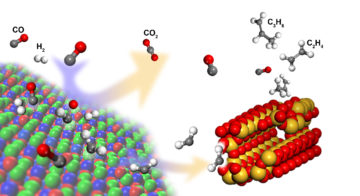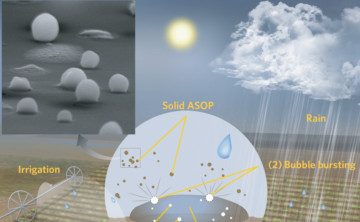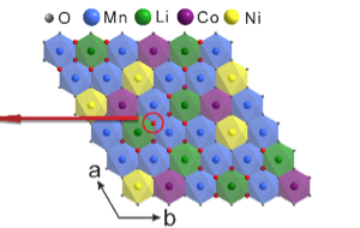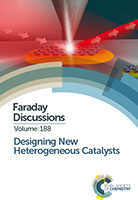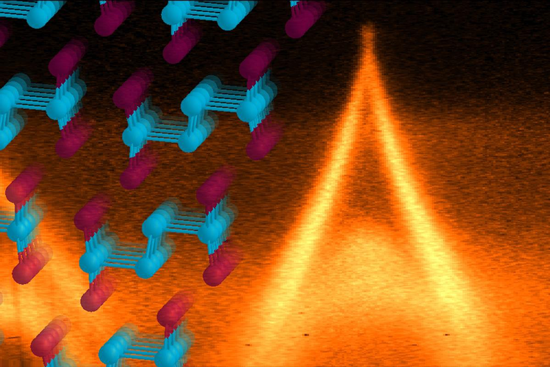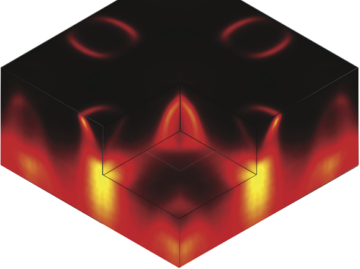Solid-oxide fuel cells (SOFCs) are a promising path toward the “clean” conversion of chemical energy to electrical energy with little or no carbon dioxide emission. With the help of the ALS, researchers from MIT recently found a way to treat SOFC cathode surfaces so that they perform better and last longer. Read more »![]()
![]()
ALS Work Using Spectroscopy
These techniques are used to study the energies of particles that are emitted or absorbed by samples that are exposed to the light-source beam and are commonly used to determine the characteristics of chemical bonding and electron motion.
New Catalyst Boosts Selective Formation of Olefins from Syngas
Experiments at the ALS have helped to explain how a new catalyst significantly boosts the selective formation of light olefin molecules—important building blocks in the petrochemical industry—from syngas. The new process could allow for the use of alternative syngas feedstocks that save water and energy. Read more »![]()
![]()
A Cleansing Rain Falls; a Soil-Filled Mist Arises
Rain’s reputation for cleansing the air may come with a caveat after new findings, including STXM and NEXAFS data, show that raindrops play a role in generating airborne organic particles. The findings could influence how scientists model our planet’s climate and future. Read more »
SINS Reveals Dopant Effects in Plasmonic Materials
Using synchrotron infrared nanospectroscopy (SINS) at the ALS, researchers have for the first time probed infrared plasmonic excitations in single nanocrystals. This allowed the pinpointing of dopant effects on an emerging class of materials with potential for molecular-sensing and energy-harvesting applications. Read more »![]()
![]()
New Insights into Oxygen’s Role in Lithium Battery Capacity
Researchers working at the ALS have recently made new discoveries in understanding the nature of charge storage in lithium-ion (Li-ion) batteries, opening up possibilities for new battery designs with significantly improved capacity. Looking at a popular Li-rich cathode material, the researchers used soft x-ray techniques to quantifiably explain oxygen’s role in Li-ion charge capacity. Read more »![]()
![]()
High spatial resolution mapping of chemically-active self-assembled N-heterocyclic carbenes on Pt nanoparticles
Many functional materials (e.g. catalysts) critically depend on the spatial distribution of surface active sites. However, most spectroscopic measurements are ensemble-based, where reactivity is averaged over millions of nanoparticles. Here, carbene attached to nanoparticle surfaces serves a model system for studying catalytic reactions on single nanoparticles. Read more »
A Novel Quasi-1D Topological Insulator
The tantalizing prospect of energy-saving, ultralow-power electronics has led to a vigorous search for optimal topological insulator materials. Now, an international team of scientists has discovered the first of a new class of topological insulators with unique properties: quasi-1D bismuth iodide. Read more »
New Fuel Cell Design Powered by Graphene-Wrapped Nanoparticles
Hydrogen is the lightest and most plentiful element on Earth and could serve as a carbon-free, virtually limitless energy source. Recently, researchers working at the ALS and the Molecular Foundry developed a promising new materials recipe based on magnesium nanocrystals and graphene for a hydrogen fuel cell with improved performance in key areas. Read more »![]()
![]()
An Atomic-Level Understanding of Copper-Based Catalysts
Copper-based catalysts are widely used in chemical industries to convert water and carbon monoxide to hydrogen, carbon dioxide, and methanol. There are theoretical models used to explain this reaction, but a complete understanding of the process has been lacking. However, recent research at the ALS has shed light on the process, giving scientists key data about how copper-based catalysts function at the atomic level. Read more »![]()
![]()
A New Universal Parameter for Superconductivity
Scientists have been researching high-temperature (high-Tc) superconductors for decades with the goal of finding materials that express superconducting capabilities at room temperature, which would be a requirement for practical and cost-effective applications. The newest materials to gain scientific interest are iron-based superconductors, and the latest research from the ALS on these materials indicates a new factor that determines their superconductivity. Read more »![]()
![]()
- « Previous Page
- 1
- …
- 24
- 25
- 26
- 27
- 28
- …
- 30
- Next Page »

